Only rarely does Shinjuku look as magical as it does here in this time-lapse video shot over the course of a year from various locations. The dreamy ambient track is from Cliff Martinez's score for the movie Solaris (2002).
(Thanks, Sam!)
Enter the Jellyfish Fantasy Hall at Enoshima Aquarium south of Tokyo and you will find yourself surrounded by dazzling swarms of gently pulsating creatures. Here's a look at a few of the species on display there.
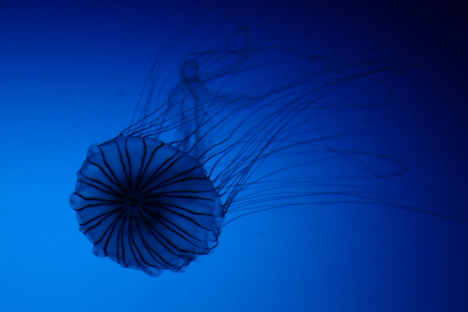
Japanese sea nettle [+]
Jellyfish, which have inhabited the world's oceans in one form or another for over one billion years, come in a dizzying array of shapes, sizes and colors. One species commonly found in Japanese coastal waters in spring and summer is the Japanese sea nettle (Chrysaora melanaster). When full grown, this jelly can reach up to 1 meter (3 ft) in length with an umbrella measuring 20 centimeters (8 in) in diameter.
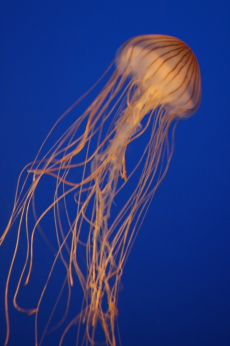
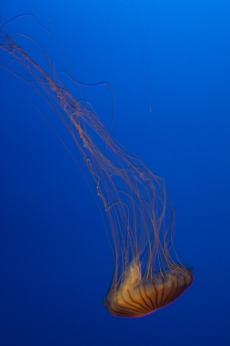
Japanese sea nettle [+] // [+]
The Japanese sea nettle has a relatively strong toxin. If dried and ground into powder, the toxin can irritate the eyes and nose when scattered on the wind. Ninja used to use this jellyfish powder as a weapon, and even today the jellyfish is known in Japan as hakushon-kurage ("sneeze jellyfish").
* * * * *
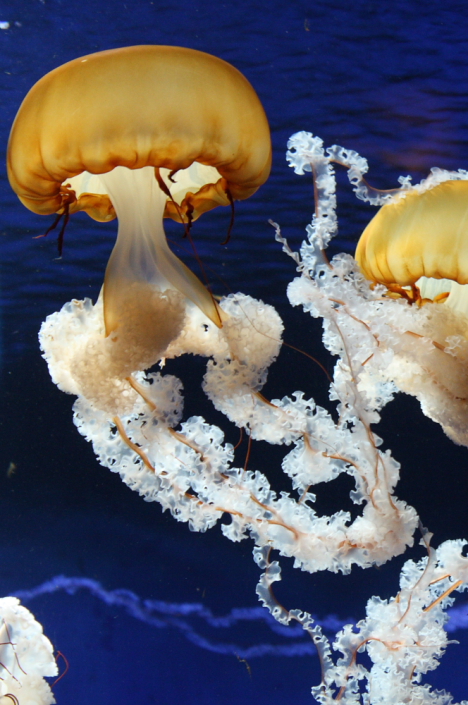
Pacific sea nettle [+]
The Pacific sea nettle (Chrysaora fuscescens) is one of the world's largest jellyfish, with an umbrella that typically measures up to 50 centimeters wide and tentacles that stretch up to 2 meters (6.5 ft) in length. It has a moderate to severe sting that can cause welts to form.
Found in the northwestern Pacific along the North American coast (and not in Japanese waters), this sea nettle has adapted to the cold California Current.
* * * * *
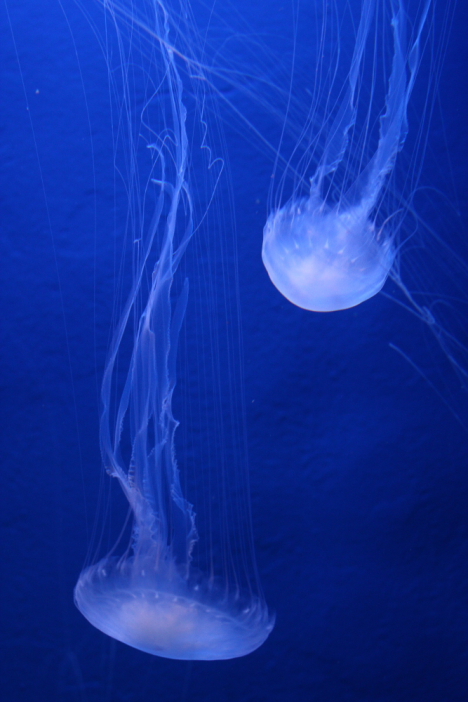
Atlantic sea nettle [+]
The Atlantic sea nettle (Chrysaora quinquecirrha) is found in the Atlantic along the North American coast, and like its Pacific cousin, this jelly can inflict a nasty sting. Its semi-transparent body makes it difficult to spot -- a problem both for beachgoers and for the sea nettle's prey.
* * * * *
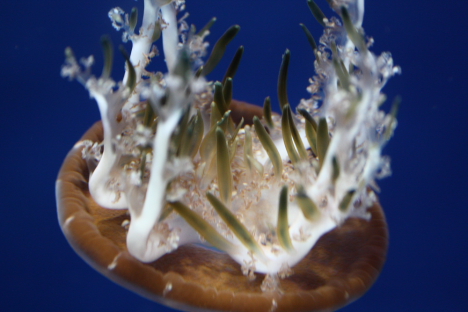
Upside-down jellyfish [+]
The upside-down jellyfish (Cassiopea sp.), which has an umbrella that typically grows to about 20 centimeters (8 in) in diameter, is found in shallow waters from the tropics to the subtropics.
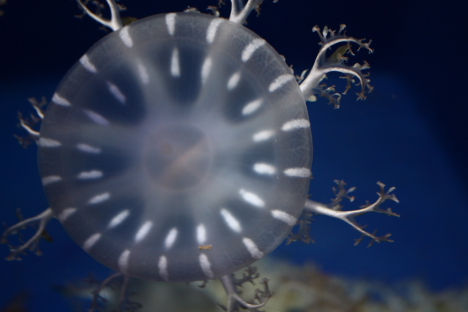
Upside-down jellyfish [+]
This jellyfish gets its name from the fact that it is usually seen upside-down on the sea floor, where it feeds on small plankton that drop down from above.
* * * * *
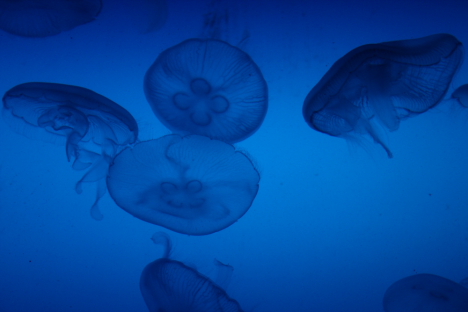
Moon jelly [+]
The moon jelly (Aurelia aurita) is probably the world's most widely distributed jellyfish. It is quite commonly found along the shores of Japan. Although it is composed of more than 95% water, it has an amazing ability to quickly heal itself, even after severe injuries. The moon jelly typically grows to a length of 15 centimeters (6 in) from the top of the umbrella to tip of the tentacles, with a diameter of 30 centimeters (1 ft).
* * * * *
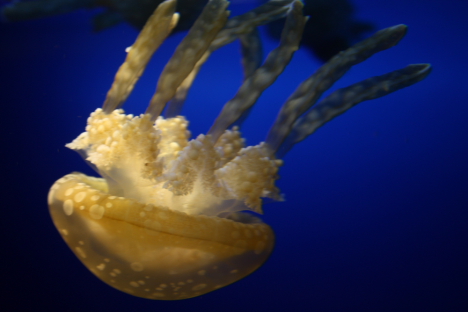
Spotted jellyfish [+]
The spotted jellyfish (Mastigias papua) has a brownish umbrella with white spots. With thick tentacles resembling the arms of an octopus, this creature is known in Japan as tako-kurage, or "octopus jellyfish." The spotted jellyfish gets its color from the algae that lives within its umbrella. This algae produces a type of sugar through photosynthesis that serves as a nutrient for this jellyfish.
Instead of one single mouth, the spotted jellyfish appears to have several smaller mouth openings in its oral arms.
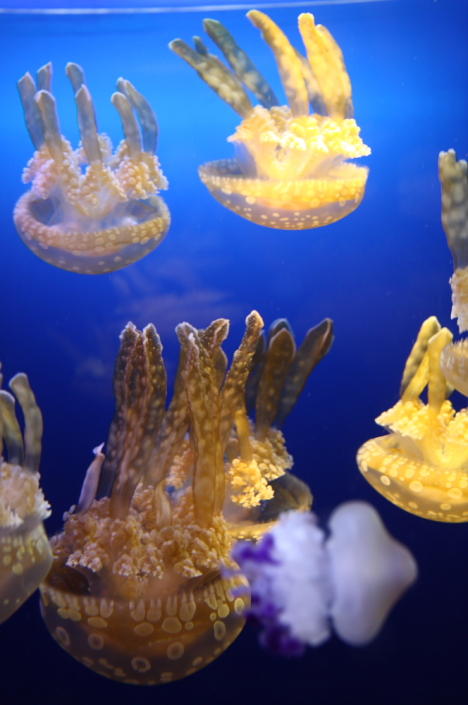
Spotted jellyfish [+]
Though mainly found in the southern Pacific Ocean, the spotted jellyfish is active in Japanese waters from summer to autumn. When full grown, this jellyfish measures about 50 centimeters (1 ft 8 in) from top to bottom and 15 centimeters (6 in) wide.
* * * * *
Other species found in the Jellyfish Fantasy Hall include the blue jellyfish (Catostylus mosaicus), brownbanded moon jelly (Aurelia limbata), and Amakusa jellyfish (Sanderia malayensis).
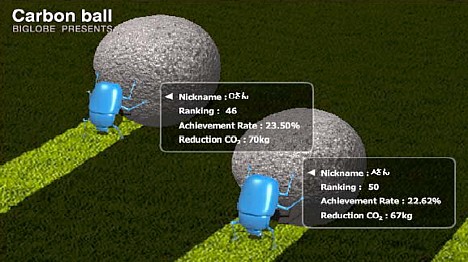
A new online service developed by electronics giant NEC offers carbon-conscious households a fun and friendly way to keep tabs on their energy consumption, as well as that of their neighbors.
Developed in conjunction with major Internet provider BIGLOBE, the service -- called "Carbon Diet" -- includes an easy-to-install wifi-enabled device that attaches to the home circuit breaker and measures power consumption via electric current sensors. The collected data is then periodically transferred to the home computer using a ZigBee wireless link and sent to an online server for processing.
Users can log on to the Carbon Diet website to check their daily and hourly energy consumption and see how they rank in comparison with other participating households. Users can also see how their monthly carbon footprint compares with the same month of the previous year. Based on the degree to which users actually reduce their carbon emissions, they are awarded "eco-points" that can be exchanged for virtual soil, water, flowers and grass in a nature restoration simulation game.
Participants can also view their progress in the form of a game called "Carbon Ball," which features dung beetle avatars in a "carbon ball" rolling contest. The distance each household's dung beetle travels is based on how successful they are in reducing power consumption. The game is designed to instill a sense of competition to keep users motivated and focused on reducing energy consumption.
For now, the three-month trial service is being conducted in the homes of 100 NEC employees. After the trial, NEC and BIGLOBE will work with Ex Corporation (an urban and environmental planning and consulting firm) to analyze the data and develop business models for local governments and the private sector. The company is aiming for sales of 2 billion yen ($20 million) over the next 3 years.
Here's a fansub of "Salaryman Man," an animated short by Takashi Taniguchi about a salaryman superhero who battles an evil villain threatening to destroy a company president.
+ Video
In conjunction with the upcoming release of Terminator Salvation (T4), an exhibit featuring the cyborgs from the Terminator series is now on display at Miraikan (National Museum of Emerging Science and Innovation) in Tokyo.

T-600 endoskeleton from Terminator Salvation [+]
Entitled "Terminator Exhibition - Battle or Coexistence? Robots and Our Future," the exhibit purportedly aims to inspire visitors to think about the relationship between humans and machines. Mostly, though, it offers a unique glimpse at the models and costumes used in the filming of the movies, along with details about the makeup and special effects.

T-800 endoskeleton [+]
In the first Terminator movie, which takes place in Los Angeles in 1984, a T-800 cyborg assassin is sent back in time from the year 2029 by Skynet, an artificially intelligent military computer system that rules the world under an army of cyborgs. Its mission is to erase the existence of John Connor, who in the future becomes the leader of the human resistance forces against the machines. To alter the course of history in Skynet's favor, the T-800 must terminate Sarah Connor before she gives birth to her son John.

T-800 endoskeleton [+]
The T-800 cyborg -- played by Arnold Schwarzenegger in the first three Terminator movies -- consists of a metal endoskeleton under a layer of living human tissue. The robot has excellent learning capabilities, enabling it to understand and adopt human behavior and phrases. It can also mimic voices once it hears them. A slightly improved version of the T-800 -- the T-850 -- appears in Terminator 2 and Terminator 3.

T-800: Hasta la vista, baby [+]
In Terminator 2, Skynet sends the latest Terminator model -- the T-1000 -- to Los Angeles in 1994 to eliminate the 10-year-old John Connor. At the same time, the resistance forces send a hacked T-800 from the future to protect John. The T-1000, which is much more advanced than the T-800, has no endoskeleton and consists of a shape-shifting liquid metal. The T-1000 is not displayed in this exhibit.
In Terminator 3, the T-800 (T-850) is again sent from the future to protect John Connor. This time it does battle with the T-X, a super-powerful Terminator that combines the exoskeleton of the T-800 with the shape-shifting liquid metal of the T-1000.

T-X (a.k.a. Terminatrix) [+]
The T-X, also called "Terminatrix," takes the shape of a beautiful woman and incorporates a variety of weapons into its endoskeleton. In addition to conducting DNA analysis by tasting blood, the shape-shifting assassin can remotely control other machines and Terminators.

Cameron Phillips (TOK715) [+]
Other items on display include a reproduction of Cameron Philips (TOK715), a reprogrammed Terminator from the "Sarah Conner Chronicles" TV series.
The exhibit also includes a few props and movie trailers from the forthcoming film.

T-600 endoskeleton [+]
Set in the year 2018, Terminator Salvation will prominently feature the T-600, an early Terminator prototype. Unlike the T-800 portrayed by Schwarzenegger in the previous films, the more primitive T-600 features an endoskeleton covered in synthetic skin instead of living human tissue. At 8 feet tall, it is also much bulkier.

Moto-Terminator [+]
Also on display is the Moto-Terminator, a motorcycle-based death machine, as well as the Hydrobot (not pictured here), a menacing eel-like underwater robot.
The final section of the exhibit introduces a variety of Japanese robot technology, mostly in the form of text-heavy exhibits (Japanese only). However, an Actroid -- smartly dressed in a skin-tight black jumpsuit -- is on hand to liven things up.

Actroid [+]
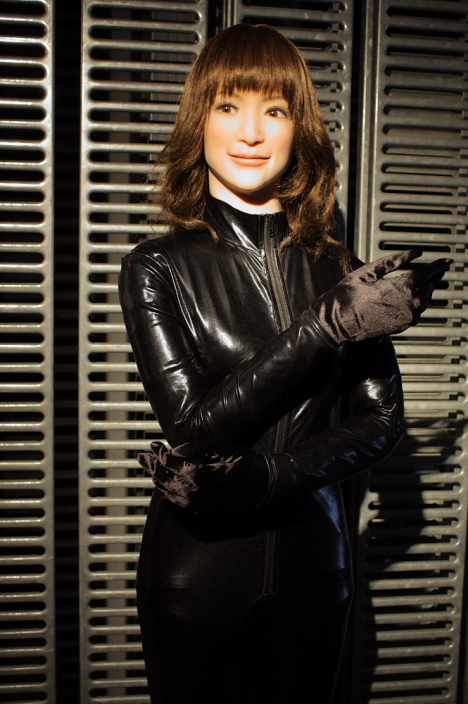
Actroid [+]
The exhibit runs until June 28, 2009.

Sculptor Kenji Yanobe's Giant Torayan robot, a 7.2-meter (24-ft) tall mechanical baby that sings, dances and spits fire, was sighted in Tokyo's Roppongi district last night. The fire-breathing robot spent the night on center stage at "Roppongi Art Night," an all-night event featuring installations and performances by dozens of artists at various venues in the area.

[+]

[+]

[+]

[+]
+ Video
The Open Reel Ensemble adds a unique twist to the old-school art of reel-to-reel tape scratching, with USB controllers that manipulate the switches inside the tape decks and with solenoids that create vibrato effects by tweaking the speed of the tape as it passes over the heads.

The city of Hakodate, Japan has been producing official tourism videos unlike any you've ever seen before -- action-packed affairs starring famous landmarks as giant robots that battle a runaway mechanical squid hijacked by vengeful aliens.
The first video begins with an interesting factoid: According to a survey of 100 aliens, Hakodate is the number one city they would most like to invade.
+ Video 1
The invaders here are alien cephalopods from the planet Ikaaru, who seek revenge on the people of Hakodate for eating too much squid. The aliens hijack an enlarged version of Hakodate's tourism mascot -- a mechanical squid named "Ikabo," which was built by Future University-Hakodate (FUN) in 2007 -- and send it on a rampage through the city.

Angry alien squid from Ikaaru: "All they eat is squid!"
A pair of giant robots are called into action to protect Hakodate's precious historical buildings from destruction. Hakodate's Goryōkaku Tower transforms into a deadly fighting machine, while an enormous Chūkū Dogū (a treasured 3,200-year-old hollow clay figurine unearthed in Hokkaidō in 1975) awakens from a deep slumber.

Giant Chūkū Dogū wakes up
The city's star-shaped Goryōkaku fortress also joins the fight. After coming under attack, the fortress rises up from the flames and takes off like a giant spaceship.
+ Video 2
In the second video, the battle between the hijacked Ikabo squid robot and the Goryōkaku Tower robot rages on into winter.
+ Video 3
In the final video, the fierce battle appears to end as the Goryōkaku ship delivers a deadly blow to the Ikaaru spacecraft. But the fight has really only just begun -- another fleet of alien ships is fast approaching.
Hakodate appears to be under full-scale alien attack and its survival is in question. Visit Hakodate soon... before it's too late.
"Battle of the Natsu-yasumi," a photo series by Fumio Nabata, presents a unique underwater perspective of goldfish scooping, a traditional game typically played at summer festivals in Japan.
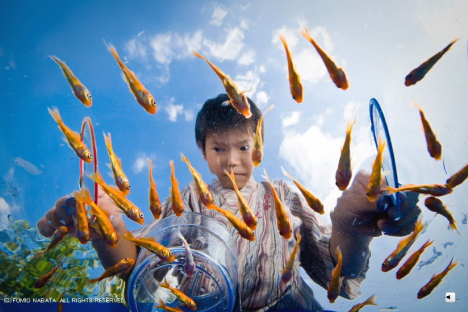
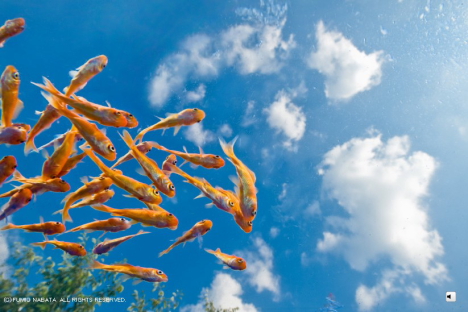

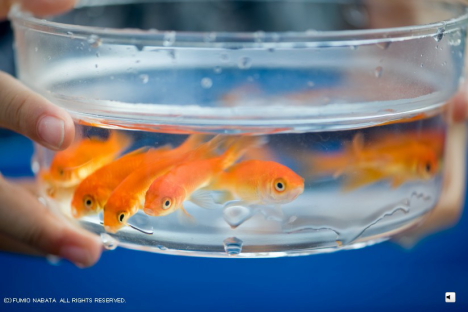

The series was selected as a grand-prize winner of the 2009 APA Award sponsored by the Japan Advertising Photographer's Association.
See Nabata's website for more (and higher resolution) images.